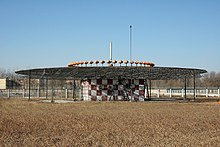
Back لوازم قياس المسافة Arabic DME Czech Distance Measuring Equipment German DME Greek Equipo medidor de distancia Spanish DME Estonian Etäisyydenmittausjärjestelmä Finnish DME (aviation) French दूरी मापक यंत्र (डीएमई) Hindi Distance Measuring Equipment ID


In aviation, distance measuring equipment (DME) is a radio navigation technology that measures the slant range (distance) between an aircraft and a ground station by timing the propagation delay of radio signals in the frequency band between 960 and 1215 megahertz (MHz). Line-of-visibility between the aircraft and ground station is required. An interrogator (airborne) initiates an exchange by transmitting a pulse pair, on an assigned 'channel', to the transponder ground station. The channel assignment specifies the carrier frequency and the spacing between the pulses. After a known delay, the transponder replies by transmitting a pulse pair on a frequency that is offset from the interrogation frequency by 63 MHz and having specified separation.[1]
DME systems are used worldwide, using standards set by the International Civil Aviation Organization (ICAO),[1] RTCA,[2] the European Union Aviation Safety Agency (EASA)[3] and other bodies. Some countries require that aircraft operating under instrument flight rules (IFR) be equipped with a DME interrogator; in others, a DME interrogator is only required for conducting certain operations.
While stand-alone DME transponders are permitted, DME transponders are usually paired with an azimuth guidance system to provide aircraft with a two-dimensional navigation capability. A common combination is a DME colocated with a VHF omnidirectional range (VOR) transmitter in a single ground station. When this occurs, the frequencies of the VOR and DME equipment are paired.[1] Such a configuration enables an aircraft to determine its azimuth angle and distance from the station. A VORTAC (a VOR co-located with a TACAN) installation provides the same capabilities to civil aircraft but also provides 2-D navigation capabilities to military aircraft.
Low-power DME transponders are also associated with some instrument landing system (ILS), ILS localizer and microwave landing system (MLS) installations. In those situations, the DME transponder frequency/pulse spacing is also paired with the ILS, LOC or MLS frequency.
ICAO characterizes DME transmissions as ultra high frequency (UHF). The term L-band is also used.[4]
Developed in Australia, DME was invented by James "Gerry" Gerrand[5] under the supervision of Edward George "Taffy" Bowen while employed as Chief of the Division of Radiophysics of the Commonwealth Scientific and Industrial Research Organisation (CSIRO). Another engineered version of the system was deployed by Amalgamated Wireless Australasia Limited in the early 1950s operating in the 200 MHz VHF band. This Australian domestic version was referred to by the Federal Department of Civil Aviation as DME(D) (or DME Domestic), and the later international version adopted by ICAO as DME(I).
DME is similar in principle to secondary radar ranging function, except the roles of the equipment in the aircraft and on the ground are reversed. DME was a post-war development based on the identification friend or foe (IFF) systems of World War II. To maintain compatibility, DME is functionally identical to the distance measuring component of TACAN.
- ^ a b c Annex 10 to the Convention on International Civil Aviation, Volume I – Radio Navigation Aids; International Civil Aviation Organization; International Standards and Recommended Practices.
- ^ Minimum Operational Performance Standards for Airborne Distance Measuring Equipment (DME) Operating Within the Radio Frequency Range of 960-1215 Megahertz; RTCA; DO-189; 20 September 1985.
- ^ Distance Measuring Equipment (DME)Operating Within the Radio Frequency Range of 960-1215 Megahertz; European Union Aviation Safety Agency; ETSO-2C66b; 24 October 2003.
- ^ "Appendix B: IEEE Standard Letter Designations for Radar Bands". Handbook of Frequency Allocations and Spectrum Protection for Scientific Uses (2nd ed.). National Academies of Sciences, Engineering, and Medicine. 2015. doi:10.17226/21774. ISBN 978-0-309-37659-4.
- ^ "Engineer exploded myths in many fields". 9 January 2013 – via The Sydney Morning Herald.